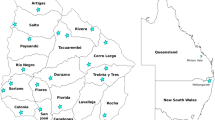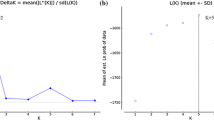Abstract
Holocryphia capensis is a recently described fungus that infects native Metrosideros angustifolia (Myrtaceae, Myrtales) trees in South Africa. This species is related to a number of serious canker pathogens of trees in the Cryphonectriaceae. An ability to produce lesions on M. angustifolia in artificial inoculation studies and its close relationship to the introduced eucalypt pathogen, H. eucalypti, raises concerns as to its diversity and possible impact on Myrtaceae in Southern Africa. Eight microsatellite markers were used to study the genetic diversity of H. capensis isolates from four sites in the Western Cape Province. All isolates could be assigned to one population, with very low gene and genotypic diversity. This was despite the fact that sexual structures of the fungus are found on infected trees. The results suggest that H. capensis could have been introduced into the Western Cape from a single, as yet unknown origin. Pathogenicity tests showed that H. capensis is pathogenic to the tested Eucalyptus clone.


Similar content being viewed by others
References
Anagnostakis SL (1987) Chestnut blight: the classical problem of an introduced pathogen. Mycologia 79:23–37
Barnes I, Nakabonge G, Roux J, Wingfield BD, Wingfield MJ (2005) Comparison of populations of the wilt pathogen Ceratocystis albifundus in South Africa and Uganda. Plant Pathol 54:189–195
Barton NH, Charlesworth B (1984) Genetic revolutions, founder effects, and speciation. Annu Rev Ecol Evol S 15:133–164
Brasier CM (2000) Intercontinental spread and continuing evolution of the Dutch elm disease pathogens. In: Dunn CP (ed) The elms: breeding, conservation, and disease management. Kluwer Academic Publishers, Boston, USA, pp. 61–72
Carnegie AJ (2007) Forest health condition in New South Wales, Australia, 1996–2005. II. Fungal damage recorded in eucalypt plantations during forest health surveys and their management. Australas Plant Pathol 36:225–239
Carnegie AJ, Lidbetter JR, Walker J, Horwood MA, Tesoriero L, Glen M, Priest M (2010) Uredo rangelii, a taxon in the guava rust complex, newly recorded on myrtaceae in Australia. Australas Plant Pathol 39:463–466
Chen RS, Boeger JM, McDonald BA (1994) Genetic stability in a population of a plant pathogenic fungus over time. Mol Ecol 3:209–218
Chen SF, Wingfield MJ, Roux J (2013) Diversimorbus metrosiderotis gen. et sp. nov. and three new species of Holocryphia (Cryphonectriaceae) associated with cankers on native Metrosideros angustifolia trees in South Africa. Fungal Biology 117:289–310
Coutinho TA, Wingfield MJ, Alfenas AC, Crous PW (1998) Eucalyptus rust: a disease with a potential for serious international implications. Plant Dis 82:819–825
Evanno G, Regnaut S, Goudet J (2005) Detecting the number of clusters of individuals using the software STRUCTURE: a simulation study. Mol Ecol 14:2611–2620
Falush D, Stephens M, Pritchard JK (2003) Inference of population structure using multilocus genotype data: linked loci and correlated allele frequencies. Genetics 164:1567–1587
Glen M, Alfenas AC, Zauza EAV, Wingfield MJ, Mohammed C (2007) Puccinia psidii, a threat to the Australian environment and economy – a review. Australas Plant Pathol 36:1–16
Gryzenhout M, Myburg H, Van der Merwe NA, Wingfield BD, Wingfield MJ (2004) Chrysoporthe, a new genus to accommodate Cryphonectria cubensis. Stud Mycol 50:119–142
Gryzenhout M, Myburg H, Hodges CS, Wingfield BD, Wingfield MJ (2006a) Microthia, Holocryphia and Ursicollum, three new genera on eucalyptus and Coccoloba for fungi previously known as Cryphonectria. Stud Mycol 55:35–52
Gryzenhout M, Rodas CA, Menas Portales J, Clegg P, Wingfield BD, Wingfield MJ (2006b) Novel hosts of the Eucalyptus canker pathogen Chrysoporthe cubensis and a new Chrysoporthe species from Colombia. Mycol Res 110:833–845
Gryzenhout M, Wingfield BD, Wingfield MJ (2009) Taxonomy, phylogeny, and ecology of bark-inhabiting and tree pathogenic fungi in the cryphonectriaceae. APS Press, St. Paul, Minnesota, USA
Gryzenhout M, Vermeulen M, Dick M, Wingfield MJ (2010) The Eucalyptus canker pathogen Holocryphia eucalypti on Eucalyptus in New Zealand. Australasian Plant Disease Notes 5:5–8
Heath R, Gryzenhout M, Roux J, Wingfield MJ (2006) Discovery of the canker pathogen Chrysoporthe austroafricana on native Syzygium spp. in South Africa. Plant Dis 90:433–438
Heath R, Roux J, Gryzenhout M, Carnegie AJ, Smith IW, Wingfield MJ (2007) Holocryphia eucalypti on Tibouchina urvilleana in Australia. Australas Plant Pathol 36:560–564
Kamgan Nkuekam G, Barnes I, Wingfield MJ, Roux J (2009) Distribution and population diversity of Ceratocystis pirilliformis in South Africa. Mycologia 101:17–25
McDonald BA (1997) The population genetics of fungi. Tools and techniques. Phytopathology 87:448–453
McDonald BA, Linde C (2002) Pathogen population genetics, evolutionary potential, and durable resistance. Annu Rev Phytopathol 40:349–379
McDonald BA (2004) Population genetics of plant pathogens. The Plant Health Instructor. doi:10.1094/PHI-A-2004-0524-01
Myburg H, Wingfield BD, Wingfield MJ (1999) Phylogeny of Cryphonectria cubensis and allied species inferred from DNA analysis. Mycologia 91:243–250
Myburg H, Gryzenhout M, Heath RN, Roux J, Wingfield BD, M.J W (2002) Cryphonectria canker on Tibouchina in South Africa. Mycol Res 106:1299–1306
Nakabonge G, Cortinas MN, Roux J, Gryzenhout M, Wingfield BD, Wingfield MJ (2005) Development of polymorphic microsatellite markers for the fungal pathogen Cryphonectria eucalypti. Mol Ecol Notes 5:558–561
Nakabonge G, Roux J, Gryzenhout M, Wingfield MJ (2006) Distribution of Chrysoporthe canker pathogens on Eucalyptus and Syzygium species in eastern and southern Africa. Plant Dis 90:734–740
Nakabonge G, Burgess T, Gryzenhout M, Wingfield B, Wingfield MJ, Roux J (2008) Population structure of the fungal pathogen Holocryphia eucalypti in Australia and South Africa. Australas Plant Pathol 37:154–161
Nei M (1973) Analysis of gene diversity in subdivided populations. PNAS 70:3321–3323
Old KM, Murray DIL, Kile GA, Simpson J, Malafant KWJ (1986) The pathology of fungi isolated from eucalypt cankers in south-eastern Australia. Australian Forest Research 16:21–36
Pegg GS, Giblin FR, McTaggart AR, Guymer GP, Taylor H, Ireland KB, Shivas RG, Perry S (2014) Puccinia psidii in Queensland, Australia: disease symptoms, distribution and impact. Plant Pathol 63:1005–1021
Pritchard JK, Stephens M, Donnelly P (2000) Inference of population structure using multilocus genotype data. Genetics 155:945–959
Rodas CA, Gryzenhout M, Myburg H, Wingfield BD, Wingfield MJ (2005) Discovery of the Eucalyptus canker pathogen Chrysoporthe cubensis on native Miconia (melastomataceae) in Colombia. Plant Pathol 54:460–470
Roux J, Nakabonge G (2010) First report of Holocryphia eucalypti on Eucalyptus grandis in Uganda. Plant Pathol 59:409
Stoddart JA, Taylor JF (1988) Genotypic diversity: estimation and prediction in samples. Genetics 118:705–711
Van der Merwe NA, Wingfield BD, Wingfield MJ (2003) Primers for the amplification of sequence-characterized loci in Cryphonectria cubensis populations. Mol Ecol Notes 3:494–497
Van der Merwe NA, Gryzenhout M, Steenkamp ET, Wingfield B, Wingfield MJ (2010) Multigene phylogenetic and population differentiation data confirm the existence of a cryptic species within Chrysoporthe cubensis. Fungal Biology 114:966–979
Van der Merwe NA, Steenkamp ET, Rodas C, Wingfield BD, Wingfield MJ (2013) Host switching between native and non-native trees in a population of Chrysoporthe cubensis from Colombia. Plant Pathol 62:642–648
Van der Westhuizen IP, Wingfield MJ, Kemp GHJ, Swart WJ (1993) First report of the canker pathogen Endothia gyrosa on Eucalyptus in South Africa. Plant Pathol 42:661–663
Van Heerden SW, Amerson HV, Preisig O, Wingfield BD, Wingfield MJ (2005) Relative pathogenicity of Cryphonectria cubensis on Eucalyptus clones differing in the tolerance to C. cubensis. Plant Dis 89:659–662
Venter M, Wingfield MJ, Coutinho TA, Wingfield BD (2001) Molecular characterization of Endothia gyrosa isolates from Eucalyptus in South Africa and Australia. Plant Pathol 50:211–217
Vermeulen M, Gryzenhout M, Wingfield MJ, Roux J (2011) New records of Cryphonectriaceae from southern Africa including Latruncellus aurorae gen. sp. nov. Mycologia 103:554–569
Walker AS, Gautier A, Confais J, Martinho D, Viaud M, Le Pêcheur P, Dupont J, Fournier E (2011) Botrytis pseudocinerea, a new cryptic species causing gray mold in French vineyards in sympatry with Botrytis cinerea. Phytopathology 101:1433–1445
Walker J, Old KM, Murray DIL (1985) Endothia gyrosa on Eucalyptus in Australia with notes on some other species of Endothia and Cryphonectria. Mycotaxon 23:353–370
Wardlaw TJ (1999) Endothia gyrosa associated with severe stem cankers on plantation grown Eucalyptus nitens in Tasmania. Eur J For Pathol 29:199–208
Wingfield MJ, Slippers B, Wingfield BD (2010) Novel associations between pathogens, insects and tree species threaten world forests. N Z J For Sci 40(suppl):S95–S103
Wingfield MJ, Slippers B, Roux J, Wingfield BD (2011) Fifty years of tree pest and pathogen invasions, increasingly threatening world forests. In: West Sussex C, Hoboken NJ (eds) Richardson DM. Fifty Years of Invasion Ecology, The Legacy of Charles Elton, Wiley-Blackwell, pp. 89–99
Wingfield MJ, Brockerhoff EG, Wingfield BD, Slippers B (2015) Planted forest health: the need for a global strategy. Science 349:832–836
Yeh FC, Yang RC, Boyle T (1999) POPGENE. Version 1.31. Microsoft windows based freeware for population genetic analysis. University of Alberta, Alberta
Acknowledgments
We thank the DST/NRF Centre of Excellence in Tree Health Biotechnology (CHTB) for financial support. We are grateful to Dr. Francois Roets and Ms. Tendai Musvuugwa from Stellenbosch University, as well as Mrs. Jane Forrester from Harold Porter National Botanical Gardens for assistance with field sampling, and colleagues Dr. DongHyeon Lee and Dr. MingLiang Yin in FABI for their valuable assistance on inoculation trials. We also acknowledge the Western Cape Nature Conservation Board for issuing the necessary collecting permits.
Author information
Authors and Affiliations
Corresponding author
Rights and permissions
About this article
Cite this article
Chen, S., van der Merwe, N.A., Wingfield, M.J. et al. Population structure of Holocryphia capensis (cryphonectriaceae) from Metrosideros angustifolia and its pathogenicity to Eucalyptus species. Australasian Plant Pathol. 45, 201–207 (2016). https://doi.org/10.1007/s13313-016-0399-2
Received:
Accepted:
Published:
Issue Date:
DOI: https://doi.org/10.1007/s13313-016-0399-2




